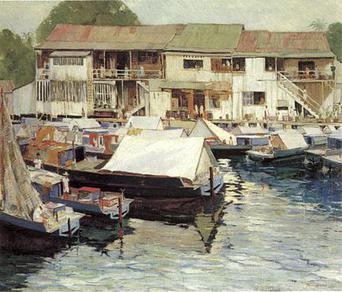Name William Twigg-Smith Died 1950 | Role Artist Children Thurston Twigg-Smith | |
 | ||
William Twigg-Smith (1883–1950) was a New Zealand-born painter, illustrator and musician, who lived most of his life in Hawaii. During World War I, he was one of the first artists to serve in the American Camouflage Corps.
Contents
After the war, he worked full-time as an illustrator for the Hawaiian Sugar Planters Association. He also had solo shows, featuring his landscapes of the region. Several of his works are held by the Honolulu Museum of Art, and are in private collections.
Early life
Twigg-Smith was born in Nelson, New Zealand. He left home for the U.S. to study art at age 16 at the Art Institute of Chicago under Harry M. Walcott.
In 1916, Twigg-Smith moved to Hawaii. He worked with Lionel Walden and D. Howard Hitchcock on creating the Pan-Pacific Carnival dioramas, which were exhibited in 1917. In the same year, he held his first art exhibit in Hawaii, in an exhibition sponsored by the Hawaii Society of Artists.
World War I
When the U.S. entered World War I in 1917, Twigg-Smith enlisted in the U.S. Army. Due to his skills as an artist, he was sent for camouflage training at Camp American University in Washington, D.C.. Afterward, he was assigned to duty in France as part of the American Camouflage Corps.
The others of the first four members of that unit were artists Sherry Edmundson Fry, Everett Herter (the brother of U.S. statesman Christian Herter) and Barry Faulkner. In his autobiography, Faulkner recalls that when Fry, Herter, and he first arrived at their tent, "we found a minstrel [Twigg-Smith], easing his solitude by playing Hawaiian airs on a ukulele. He came from the islands and was pleasant and companionable".
Most of life
After the war, Twigg-Smith returned permanently to Hawaii. On July 9, 1919 he married Margaret Carter Thurston (1895–1931), daughter of Lorrin A. Thurston. He had led the overthrow of the Kingdom of Hawaii in 1893. Their son Thurston Twigg-Smith eventually took over the Honolulu Advertiser from Margaret's brother.
In 1923, Twigg-Smith was hired as a full-time illustrator for the Hawaiian Sugar Planters' Association. Four years later, he was given a solo exhibition at the Honolulu Museum of Art. In addition to being a painter and illustrator, he was a musician, serving as second flutist for the Honolulu Symphony.
Throughout his life in Hawaii, Twigg-Smith painted landscapes, seascapes, fishing activities, harbors, urban scenes, gardens, sugar cane fields and volcanoes. The Honolulu Museum of Art holds several of his works. He died in 1950 in Kona, Hawaii.
